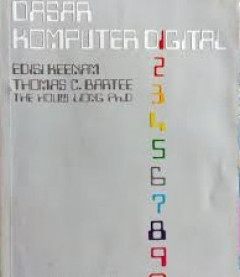Filter by

Electronic access control
Contents: PART I THE BASICS Chapter 1 Introduction and overview Chapter 2 Foundational security and access control concepts Chapter 3 How electronic access control systems work PART II HOW THINGS WORK Chapter 4 Access control credentials and credential readers Chapter 5 Types of access controlled portals Chapter 6 Life safety and exit devices Chapter 7 Door types and door f…
- Edition
- Second Edition
- ISBN/ISSN
- 9780128054659
- Collation
- xix, 544 hal.; ilus.; 24 cm
- Series Title
- --
- Call Number
- 621.389 NOR e

Principles of electric circuits: conventional current version
Table of contents: Chapter 1: Quantities and Units 1-1 Units of Measurement 1-2 Scientific Notation 1-3 Engineering Notation and Metric Prefixes 1-4 Metric Unit Conversions Chapter 2: Voltage, Current, and Resistance 2-1 Atomic Structure 2-2 Electrical Charge 2-3 Voltage, Current, and Resistance 2-4 Voltage and Current Sources 2-5 Resistors 2-6 …
- Edition
- Ninth Edition
- ISBN/ISSN
- 9780135073094
- Collation
- xv, 976 hal.; ilus.; 29 cm
- Series Title
- --
- Call Number
- 621.319 FLO p

A classical introduction to cryptography exercise book
contents: - Prehistory of Cryptography - Conventional Cryptography - Dedicated Conventional Cryptographic Primitives - Conventional Security Analysis - Security Protocols with Conventional Cryptography - Algorithmic Algebra - Algorithmic Number Theory - Elements of Complexity Theory - Public Key Cryptography - Digital Signatures - Cryptographic Protocols - From Cryptography to Com…
- Edition
- --
- ISBN/ISSN
- 9780387279343
- Collation
- xiv, 254 hal.; ilus.; 25 cm
- Series Title
- --
- Call Number
- 005.8 BAI c

Dasar komputer digital
Judul asli "Digital computer fundamentals 6/ed"
- Edition
- Edisi keenam
- ISBN/ISSN
- 33010190
- Collation
- xii, 636 hal.; ilus.; 23 cm.
- Series Title
- --
- Call Number
- 004.11 BAR d

Digital signal processing for RFID
Contents: 1. Fundamentals of RFID systems 2. Basic signal processing for RFID 3. RFID-oriented modulation schemes 4. MIMO for RFID 5. Blind signal processing for RFID 6. Anti-collision of multiple-tag RFID systems 7. Localization with RFID 8. Some future perspectives for RFID.
- Edition
- --
- ISBN/ISSN
- 9781118824313
- Collation
- xvii, 278 hal.; ilus.; 25 cm
- Series Title
- --
- Call Number
- 621.384 FEN d

Introduction to algorithms
Table of contents: I. Foundations 1. The Role of Algorithms in Computing 2. Getting Started 3. Growth of Functions 4. Divide-and-Conquer 5. Probabilistic Analysis and Randomized Algorithms II. Sorting and Order Statistics 6. Heapsort 7. Quicksort 8. Sorting in Linear Time 9. Medians and Order Statistics III. Data Structures 10. Elementary Data Structures 11. Hash Tables 12. B…
- Edition
- Third Edition
- ISBN/ISSN
- 9780262033848
- Collation
- xi, 1292 hal.; ilus.; 23 cm
- Series Title
- --
- Call Number
- 005.1 COR i

The pragmatic programmer: from journeyman to master
Content: 1. A Pragmatic Philosophy 2. A Pragmatic Approach 3. The Basic Tools 4. Pragmatic Paranoia 5. Bend, or Break 6. While You Are Coding 7. Before the Project 8. Pragmatic Projects App. A. Resources App. B. Answers to Exercises.
- Edition
- -
- ISBN/ISSN
- 9780201616224
- Collation
- xxiv, 321 hlm.; ilus.; 24 cm
- Series Title
- -
- Call Number
- 005.1 HUN p

Introduction to Computer Programming IBM System/360 PL/I
- Edition
- Ketujuh
- ISBN/ISSN
- 0-88236-190-2
- Collation
- 360 hlm.; 27 cm
- Series Title
- -
- Call Number
- 005 SHE I
- Edition
- Ketujuh
- ISBN/ISSN
- 0-88236-190-2
- Collation
- 360 hlm.; 27 cm
- Series Title
- -
- Call Number
- 005 SHE I

Systems analysis and design
- Edition
- fifth Edition
- ISBN/ISSN
- 789566494
- Collation
- xvi, 640 hlm.; ilus.; 28 cm.
- Series Title
- -
- Call Number
- -
- Edition
- fifth Edition
- ISBN/ISSN
- 789566494
- Collation
- xvi, 640 hlm.; ilus.; 28 cm.
- Series Title
- -
- Call Number
- -

An Introduction to collective bargaining and industrial relations
Authored by a well-respected team in labor relations, An Introduction to Collective Bargaining and Industrial Relations, 4/e covers key topics in industrial relations and collective bargaining using a unique conceptual framework based on the three levels of industrial relations activity (strategic, functional, and workplace). Two extensive, class-tested mock-bargaining exercises are included. I…
- Edition
- -
- ISBN/ISSN
- 9780071254250
- Collation
- xiii, 514 cm.; 23 cm.
- Series Title
- -
- Call Number
- 331.89 KAT i
 Computer Science, Information & General Works
Computer Science, Information & General Works  Philosophy & Psychology
Philosophy & Psychology  Religion
Religion  Social Sciences
Social Sciences  Language
Language  Pure Science
Pure Science  Applied Sciences
Applied Sciences  Art & Recreation
Art & Recreation  Literature
Literature  History & Geography
History & Geography